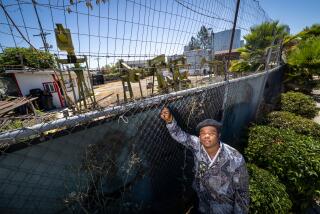Op-Ed: This year’s Earth Day will be as angry — and clever — as the one that started it 50 years ago
When people talk about what they’re missing while sheltered in place, the list tends to be restaurants, baseball, weddings. But for some of us, there was one more thing we were looking forward to: mass civil disobedience.
Wednesday marks the 50th anniversary of Earth Day, which we’ve come to think of as a joyful secular holiday devoted to environmentalism. It’s that way the world over: I opened up the Tokyo Earth Day a couple of years back with a speech, and the scene was entirely familiar, right down to the free Ben & Jerry’s ice-cream cones and a guy selling hemp T-shirts.
But that’s not how it started. The first Earth Day, in 1970, was a spasm of protest, laced with a lot of anger. It came on the heels of the Santa Barbara oil spill and the images of Cleveland’s Cuyahoga River on fire. People were clever — 60 students at Miraleste High in Palos Verdes arrived at school on horseback instead of in cars. But people were also pissed off. At Santa Monica High School, kids wore surgical masks and ceremonially buried a car engine. The Tommy Trojan statue sported a gas mask for the day. All in all, 20 million Americans poured into the streets, one of the largest single-day political actions in U.S. history.
In our “Dispatches From the Pandemic” series, we bring you personal stories from people whose lives have been altered by COVID-19.
We’ll be wearing surgical masks this Earth Day too, but more as a matter of survival than of protest, and we won’t be pouring into the streets. Like everything else, protest during a pandemic has to take other forms. We’ll be — check your surprise — moving online, with a three-day Earth Day Live extravaganza, starting Wednesday.
Just like the first Earth Day, it will be led by young people. The Greta Generation are great organizers — the global school strikes last September were among the biggest political demonstrations of this century. And it will be diverse: The environmental movement has morphed into the environmental justice movement, largely led by the people who’ve paid the biggest price for our collective inaction.
Will it be the same as demonstrating in person? Of course not. Those of us working full-time to lower Earth’s temperature had planned for this week to be a massive breakout moment for a new phase of climate campaigning. Protests were set for Chase bank branches across America, sit-ins calling attention to Chase’s woeful record as the biggest funder of fossil fuels on Earth. Some of us went to jail in January for launching those sit-ins, and we were confident that this week, at least half the banking giant’s 5,200 retail operations across America would see demonstrations.
But of course civil disobedience is high on the list of things that don’t make sense right now: The people already in our jails are at high risk from coronavirus; all they need is a bunch of newcomers potentially tracking in microbes from the outside.
And so we’ll adapt, as everyone is adapting.
Going online has some advantages (at the very least, there will be no trolls complaining that the whole affair is bankrupt because some of the buses carrying protesters to the demonstrations run on gas). And we’ll be able to see each other, around the globe — a kind of Zoom call for the planet.
Even better, the odd circumstances of this year’s commemoration will send another message. The air outside for Earth Day 50 will be, in most places, the cleanest in living memory. People everywhere can suddenly see vistas that had been shrouded in haze since they were born. Many people are getting, literally, their first lungfuls of truly clean air. It’s as if they’ve been put in a time machine and sent way, way back. Or, if we’re more hopeful, a few years forward.
Because we now have the technology required to make sure no one has to breathe filthy air again. In the last 10 years, engineers have driven the price of sun and wind power down below coal; there’s no reason for a power plant to belch particulates. In the last 10 years, engineers have built electric cars that are elegant and affordable; there’s no reason for morning and afternoon peaks of pollution. In the last 10 years, cities such as Copenhagen have shown there’s far less need for cars than we thought: Even in Denmark’s difficult weather, most people commute via bike.
All that’s missing for rapid change is political will. And maybe the clear skies of this spring, and the overall reckoning of a deathly pandemic, will help provide that will. Who, once they’ve seen the mountains in sharp relief, wants to go back to the haze? Who, now that they have to focus on the health of their lungs, wants to breathe that crap? Who, now that we’ve seen how fast good governments can move, wouldn’t want to use this moment to help avert the even more dangerous crises that global warming is sending our way?
This won’t look like any Earth Day since the first one. Because we can see more clearly now, in all kinds of ways.
Bill McKibben is the founder of the climate campaign 350.org, Schumann Distinguished Scholar at Middlebury College in Vermont and the author most recently of “Falter: Has the Human Game Begun to Play Itself Out?”
More to Read
A cure for the common opinion
Get thought-provoking perspectives with our weekly newsletter.
You may occasionally receive promotional content from the Los Angeles Times.











